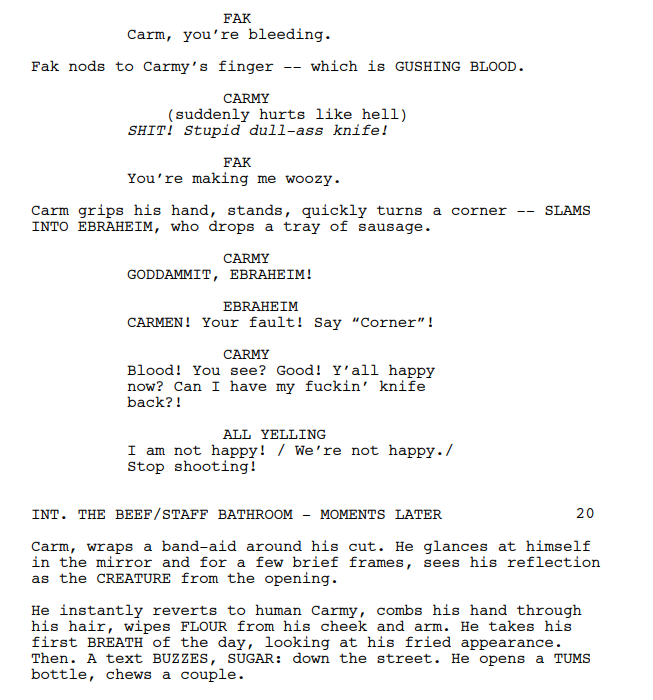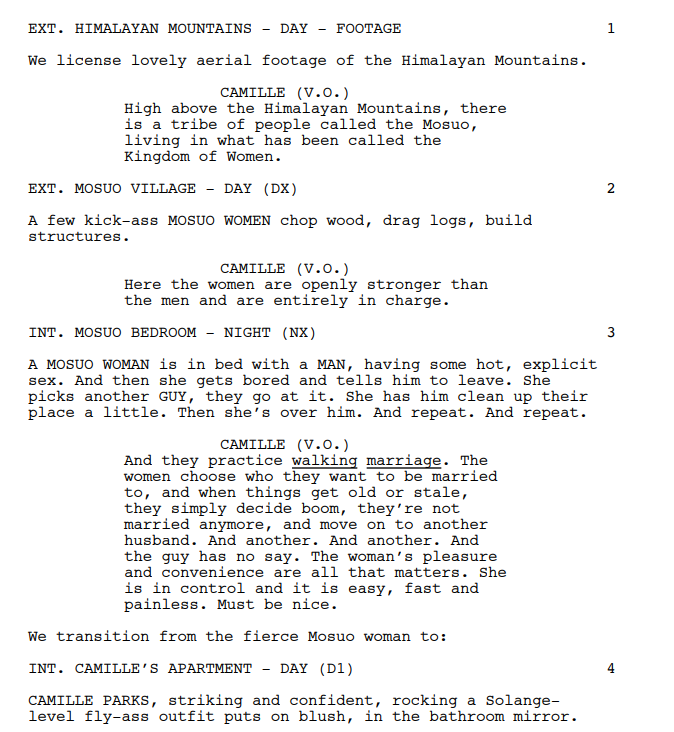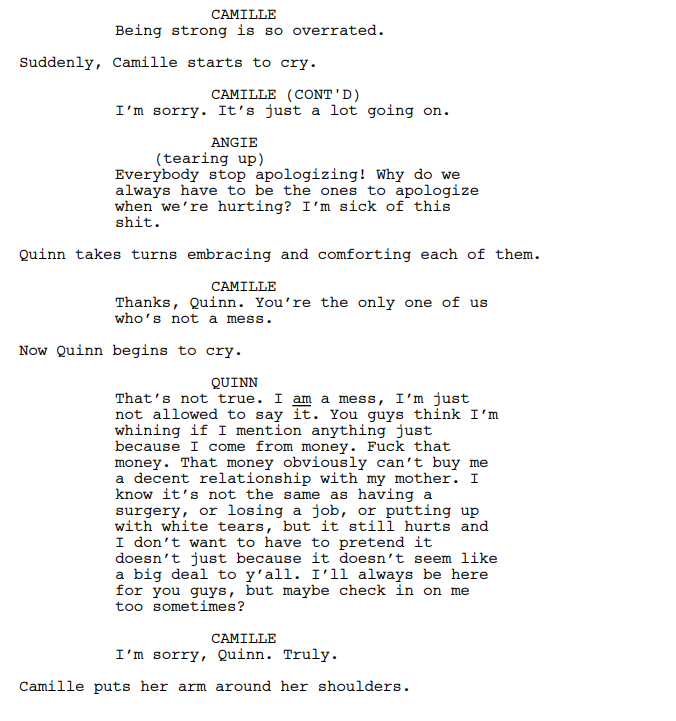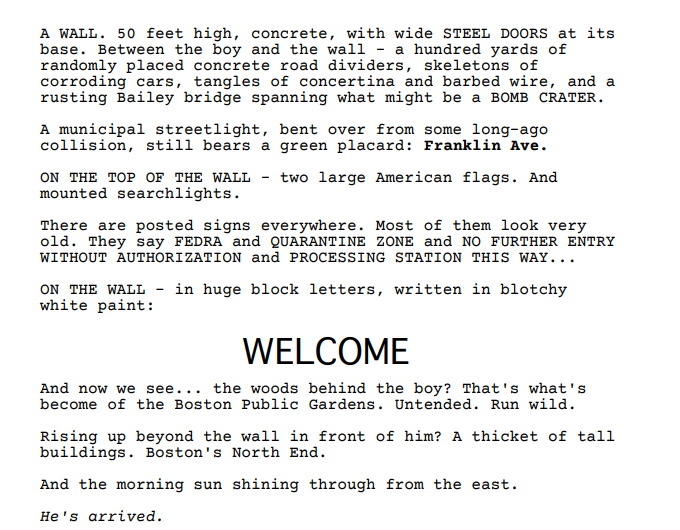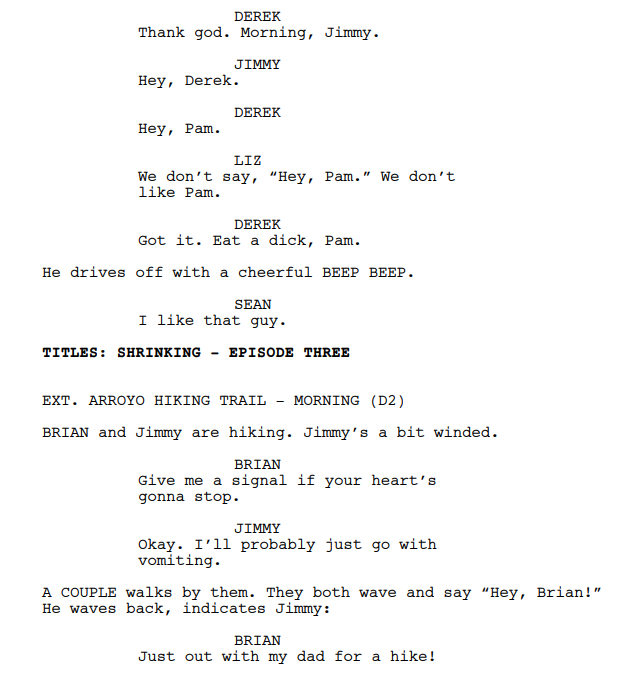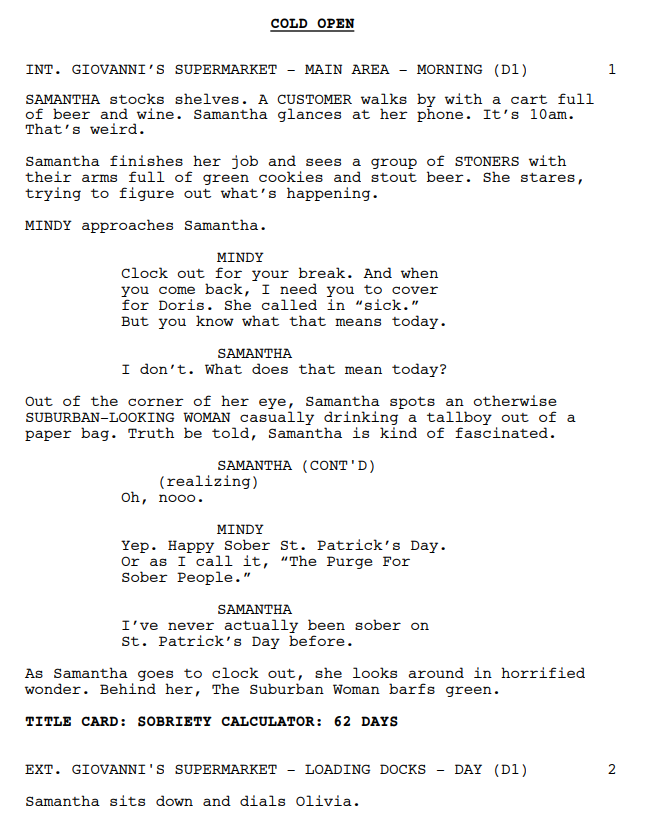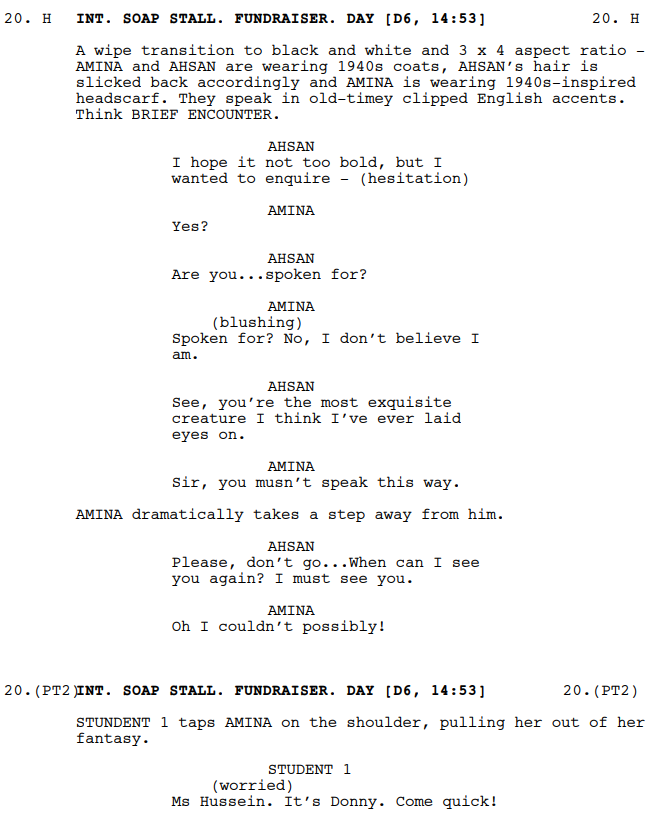FORMATTING YOUR SPEC SCRIPT, A PRIMER: PART 23
If you’re applying to a fellowship, taking a TV writing class or just trying to learn the ins and outs of TV script formatting, the WGF Library likely has scripts you want to read for research—scripts you can’t find anywhere else.
If you live outside LA, can’t come into the library for whatever reason, or are just looking for a distillation of how popular/current shows are formatted, this blog series is for you. These primers are meant to supply the notes you’d take if you visited the library to read scripts in person.
We hope this jump-starts your research and writing. Just remember, especially if you’re writing a spec for a fellowship application, formatting should be a secondary concern behind knocking the readers’ socks off with a gut-punch of a story. These posts are not an excuse for you to obsess over formatting at the expense of story. You’ll get the most out of it if you use this post to get a feel for how television is generally formatted.
Remember: We aren’t able to send out scripts as we are not the copyright holders. If you have further, more specific questions about the shows covered in this (or any other) formatting post, please e-mail us at library@wgfoundation.org and we can help clarify or provide more info.
THE BEAR (Hulu)
**Note: As of the writing of this post, we only have the pilot and season 1 finale of The Bear, so those are the only two scripts used in compiling this data.
Average page count: 33-34
Average scene count: 34-37
Broken into acts? No
Other things to consider:
The important thing to remember is that this is a high energy show with lots of fast talking and action. Don't be afraid to have long blocks of quick-paced description. To convey the quick pace, sometimes sentences are only two words long.
It's written like an action movie, but the action is cooking.
Each character has a really distinct voice and dialogue can move at a breakneck speed. There are sometimes pages with lots of dialogue and lots of white space. Keep it simple. In the finale, Carmy has a monologue that goes for a whole page and is not interrupted with any description.
Text messages and any written text we see on screen is usually bolded. Elsewhere, ALL-CAPS can sometimes be used for significant sounds or visuals. The main thing is to keep it quick and choppy.
The scripts are not broken into acts, but end with "END OF EPISODE." on the right-hand side in ALL-CAPS and with a period.
HARLEM (Amazon)
Average page count: 31-33
Average scene count: 17-46 (don’t sweat the scene count — it varies)
Broken into acts? No
Other things to consider:
Scripts often open with Camille's voice-over with some animation or stock footage or her walking around Harlem. What's written in these fantastical sequences is often very practical and straightforward. See example below.
These scripts feature more word-heavy blocks of description that are rich in detail and really draw the reader in.
Flashbacks are noted in the scene heading, e.g. "EXT. CAMILLE'S BROWNSTONE - FOUR YEARS AGO - DAY" and when we return to the present, "EXT. CAMILLE'S BROWNSTONE - AS BEFORE"
When a character sends/receives a text message or reads a tweet, the words of the text or tweet are simply put into quotation marks in the description, i.e. - ‘Camille grabs her phone and opens her texts. Ian’s text: “Are we making a mistake?” looms in front of her. She starts to type back: "I’d like to think that we aren’t, but maybe we owe it to ourselves to...”’
The thing that really makes these scripts pop is each character's individual voice. We can easily cross out the names and still know who's talking. That leads the eye down the page quickly.
The scripts aren't broken into acts, but each script ends with “END OF EPISODE” bolded, CAPITALIZED and underlined.
THE LAST OF US (HBO)
Average page count: 42-67; the length varies (the pilot is 112 pages)
Average scene count: it varies wildly, so try not to worry too much about it
Broken into acts? No
Other things to consider:
All scene headings are in bold.
The prose is very visceral with descriptions of sights, sounds, and smells. Sentences are short and active. Scripts consist of A LOT of description. It’s a very visual show.
Signage on screen helps tell the story. Important signs are written in ALL-CAPS and bolded. These include highway signs like “WELCOME TO WYOMING,” FEDRA signs and graffiti. Sometimes significant signs/text are bolded in huge 48pt font or in red to really signify importance and draw the reader in.
Flashbacks are indicated by adding the year to the end of the first scene heading of the flashback and then the year 2023 when we return to the present action.
Italicized words and phrases are peppered throughout all scripts, mostly letting us know characters’ internal monologue. These are notes for the reader about what we’re feeling more than seeing. In the example below: "They aren't here for lunch. They're interrogating the hostess of the restaurant. Hmmm, wonder what she did. Another bite. Chew. Chew. Chew. The hostess nods, and points toward where Ratna is seated. Oh. Someone near me did something?"
Scripts are not broken into acts, but each script ends with "END OF EPISODE" in bold, ALL-CAPS, centered and underlined.
SHRINKING (Apple TV+)
Average page count: 32-34
Average scene count: 28-37
Broken into acts? No
Other things to consider:
Scripts use as little description as humanly possible to convey what's happening. It's mostly dialogue. Lots of short spats of back and forth dialogue.
While the scripts are not broken into acts, there is a title cue. It's formatted: TITLES: SHRINKING in bold and ALL-CAPS on the left-hand side of the page. This title cue occurs anywhere from page 3 to page 7... It's the end of a "cold open" of sorts.
Written text that we see on screen is often written in bold and in quotations.
Montages are conveyed very simply with dashes.
Flashbacks—typically with Jimmy's deceased wife Tia—are baked into the scene heading, i.e. - "INT. JIMMY'S HOUSE - LIVING ROOM - FLASHBACK" then to leave the flashback "BACK TO THE PRESENT" is used in the next scene heading.
Scripts end with "END." or "END OF EPISODE." in ALL-CAPS on the left-hand side.
SINGLE DRUNK FEMALE (Freeform)
Average page count: 25-28 (usually closer to 28)
Average scene count: 15-25
Broken into acts? Yes
Other things to consider: 3 acts (usually a cold open too and occasionally a tag)
Scripts are broken into three acts. Typically there's also a cold open. Occasionally there's a tag. If there's a cold open, it will run from 2-6 pages. Act one: 5-9 pages. Act two: 8-12. Act three: 3-5 pages. If there's a tag, it's usually 1/2 to 3/4ths of a page. Notice act two is the longest. Act three is the shortest.
Act headings/endings are formatted: COLD OPEN / END OF COLD OPEN... ACT ONE / END OF ACT ONE... centered, bolded and underlined.
At the end of act three (or the end of the tag if there is one): END OF EPISODE centered, bolded and underlined.
At some point before the end of the cold open (or the end of act one if there is no cold open), there is a title card reminding us how many days Samantha has been sober. This is formatted in ALL-CAPS and bolded on the left-hand side of the page: TITLE CARD: SOBRIETY CALCULATOR: 28 DAYS
Formatting in these scripts is simple and casual -- like a sketch rather than a full-on painting. There's occasional CAPITALIZATION of significant verbs and behaviors for emphasis. The prose is really funny.
As you can see from the scene count, longer, more dialogue-heavy scenes are okay.
Written text we see on screen is presented simply in quotes.
WE ARE LADY PARTS (Peacock)
Average page count: 27-28
Average scene count: 25-40
Broken into acts? No
Other things to consider:
Scene headings are bolded. Scene headings also use a lot of abbreviations like "UNI" or "CHEM LAB"
Blockier descriptive paragraphs are okay along with camera directions and the vibe/feeling of the scene. See how the Brief Encounter fantasy sequence below is detailed in the description.
A huge part of these scripts is the distinctiveness of each character's voice. You could cover each character's name up and still know who is talking. Amina has a sweet, nervous energy. Saira is more hard-nosed and aggressive. Since it's so easy to distinguish between characters on the page, the scripts have real flow.
The descriptions have wit and playfulness just like the central characters.
Band performances and musical numbers are specified in bold in the descriptions, then any sung lyrics are italicized.
Written text that we see on screen is also italicized in the description.
Scripts are not broken into acts, but end with "END OF EPISODE." in ALL-CAPS on the left-hand side.
Until next time, happy writing!

